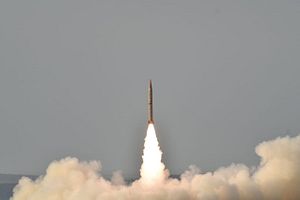The Pakistani military test fired a Shaheen-II medium-range ballistic missile (MRBM) on May 23, according to the Inter Services Public Relations (ISPR), the media arm of the Pakistan Armed Forces.
Notably, the test took place on the same day as the results of the Indian general elections began to trickle it, showing Indian Prime Minister Narendra Modi Bharatiya Janata Party (BJP) heading for another victory at the polls.
“The training launch was aimed at ensuring operational readiness of Army Strategic Forces Command,” ISPR said in a statement. “Shaheen-II Missile is capable of carrying both conventional and nuclear warheads up to a range of 1,500 kilometers [932 miles].”
The road-mobile, solid-fueled, Shaheen-II is designed to carry a single conventional or nuclear warhead. The missile was first fired in 2004 and declared operational in 2014. The missile is reportedly based on the M-11 (also known as CSS-7), a Chinese-made road mobile short-range ballistic missile.
“Shaheen-II is a highly capable missile which meets Pakistan’s strategic needs towards maintenance of desired deterrence stability in the region,” according ISPR. The missile was last tested in 2014.
ISPR spokesperson, Asif Ghafoor, said in a statement on social media that the purpose behind the May 23 launch was to reinforce Pakistan’s deterrence posture. “Shaheen-II fully meets [Pakistan’s] strat[egic] needs towards maintenance of desired deterrence stability in the region,” he said.
Pakistan has two additional MRBMs, the shorter-ranged Shaheen-I and the Ghauri, currently operationally deployed. Two other MRBMs, the Shaheen-III and the Ababeel, are currently under development by the National Development Complex.
The Shaheen-III is a liquid-fueled, multi-stage ballistic missile with an estimated range of 2,750 kilometers (1,700 miles). The Ababeel is thought to be an improved variant of the Shaheen-III. Both missiles will reportedly be capable of carrying multiple warheads using Multiple Independent Re-entry Vehicle technology (MIRV).
As I noted elsewhere, Pakistan will need to build up additional capabilities to effectively deploy MIRV missiles:
(…) Islamabad will need to further invest in and develop intelligence, surveillance, and reconnaissance (ISR) capabilities including satellite technology (e.g., by adapting and refining China’s Beidou-II satellite navigation system for Pakistan’s sea- and land-based missile systems) to operationalize ballistic missiles capable of carrying multiple warheads and field a credible MIRV capability.
Pakistan has also tested other missile systems in 2019. In January, the Pakistani Army Strategic Forces Command tested the Nasr (Hatf-IX) short-range ballistic missile twice. Pakistan introduced the missile into its arsenal in response to India’s Cold Start Doctrine (CSD).
As I noted earlier this year, CSD “was developed by the Indian Army in 2004 to facilitate smaller scale, rapid, and decisive conventional offensive operations into Pakistani territory in the event of Pakistani-sponsored asymmetrical attack on Indian soil before the international community can actively intervene, and before Pakistan would feel compelled to launch nuclear retaliatory strikes to repel an Indian invasion.”
































